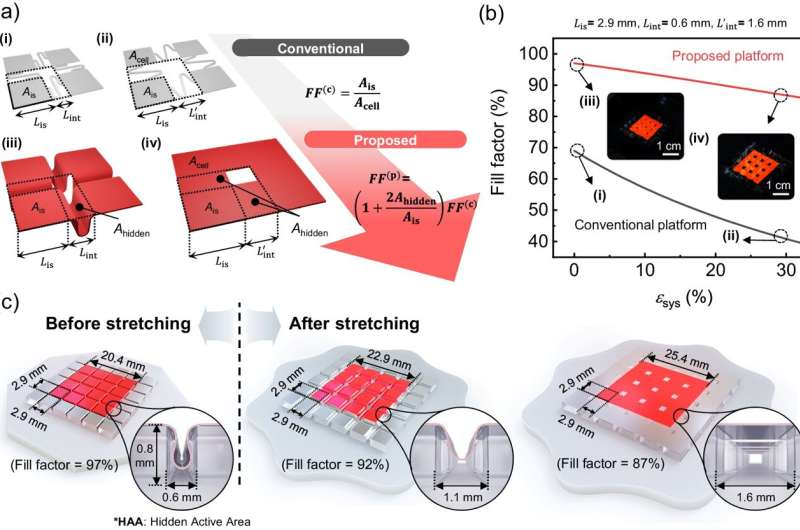Using fill factors to prevent loss of resolution in bendable video screens
A multi-institutional team of electrical engineers in the Republic of Korea has overcome the problem of resolution degradation when bendable video screens are bent. In their project, reported in the journal Nature Communications, the group added fill factors between OLEDs to retain resolution on bendable screens.
To build bendable video screens, engineers have taken two approaches: developing bendable OLEDs that sit on a bendable background or adding serpentine interconnecting material between non-bendable OLEDs mounted on bendable backgrounds.
Since a method to mass produce bendable OLEDs has proven elusive, device makers have opted for the latter option. The problem with this option is that when the device is bent, the space between the pixels grows wider, revealing a darkness gap between them, resulting in loss of resolution.
In this new effort, the research team found a possible solution—adding super-thin OLEDs between the regular OLEDs that are only seen when the device is bent.

To build such a screen, the researchers created a stretchy elastomer and patterned it with traditional square OLEDs. They then added ultra-thin OLEDs to a glass plate and pressed them to the elastomer with the ultra-thin OLEDs situated between the traditional OLEDs.
The light from the fill factors, the team notes, moves outward, but also bounces off the sides of the regular OLEDs, preventing dark gaps. Testing showed that the method improved the geometrical fill factor from 87% to 97% during normal stretching.
The research team acknowledges that their test device had a pixel density of just 11 ppi, whereas commercial devices are typically in the range 300 to 450 ppi. But they suggest that limited testing showed that their approach could be scaled up for both higher ppi and for mass production.
They further suggest that their technique could be used to cover curved surfaces, such as spheres, and down the line, possibly to make wearable electronics.
More information:
Donggyun Lee et al, Stretchable OLEDs based on a hidden active area for high fill factor and resolution compensation, Nature Communications (2024). DOI: 10.1038/s41467-024-48396-w
© 2024 Science X Network
Citation:
Using fill factors to prevent loss of resolution in bendable video screens (2024, June 5)
retrieved 6 June 2024
from https://techxplore.com/news/2024-06-factors-loss-resolution-bendable-video.html
This document is subject to copyright. Apart from any fair dealing for the purpose of private study or research, no
part may be reproduced without the written permission. The content is provided for information purposes only.

Comments are closed